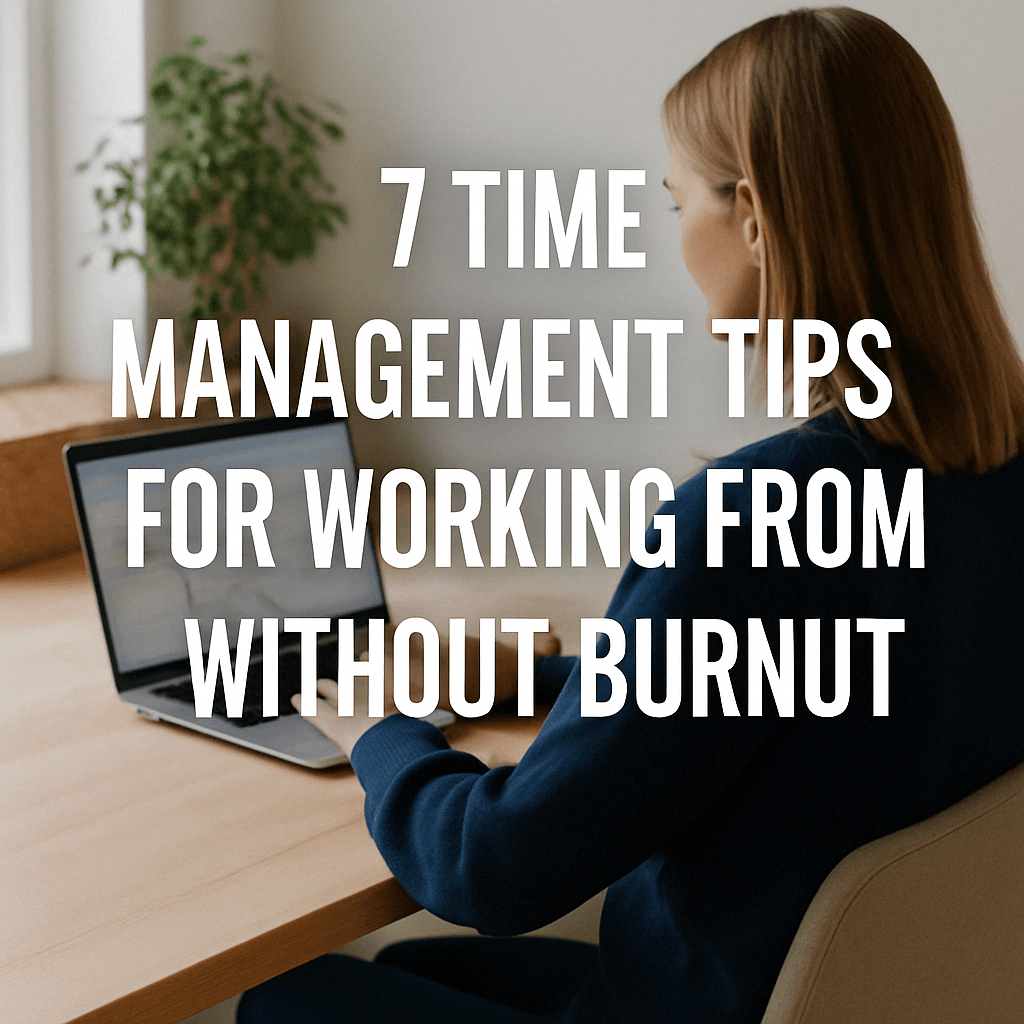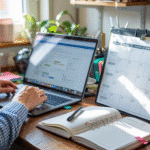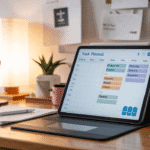Working from home sounds like a dream—no commute, comfy clothes, flexible hours. But if you’ve actually done it, you know the truth: your day can quickly dissolve into a blur of emails, laundry, back-to-back Zoom calls, and realizing you forgot to eat lunch… again.
Without the structure of an office, it’s easy for work to spill into every corner of your day. And that constant “on” feeling? It’s a shortcut to burnout.
The good news? A few smart time management shifts can completely change how your day flows—and how you feel at the end of it. You don’t need a complicated system or a productivity guru. Just a few simple strategies that actually work in real life.
Let’s dive into 7 time management tips that’ll help you work from home without burning out.
🕗 Tip #1: Set Clear Work Hours (And Actually Stick to Them)
One of the easiest ways to blur the line between “work” and “life” is by never officially starting or ending your workday. When you work from home, it’s tempting to answer just one more email after dinner—or start tackling tasks before you’ve had breakfast.
Setting clear start and stop times gives your brain a sense of structure. It also sets boundaries with others (and yourself). Whether it’s 9–5, 8–4, or split into blocks, choose hours that fit your rhythm—and commit to them.
📅 Pro tip: Add events to your calendar labeled “Workday Start” and “Workday End.” Use alarms or reminders to help you actually shut down when the day is done.
It’s not about being rigid—it’s about giving your day shape so that your mind knows when to focus and when to rest.
🛋️ Tip #2: Define a Physical Work Zone
When your work blends into your home, everything starts to feel... like work. That’s why creating a dedicated workspace, no matter how small, can have a huge impact on your focus and mental clarity.
You don’t need a fancy office. A corner of the dining table, a specific chair, or even a foldable desk can work—what matters is that it sends a signal: this is where I focus.
🧠 Your brain loves context. Sitting in the same spot every day to work helps it associate that space with productivity, just like your bed should be associated with sleep—not email.
🎧 Bonus tip: Use “focus triggers” like putting on headphones, lighting a candle, or starting with a specific playlist. These rituals help your brain shift into work mode quickly.
And when you step away from that space? You’re off. That physical separation is what helps your mind unplug.
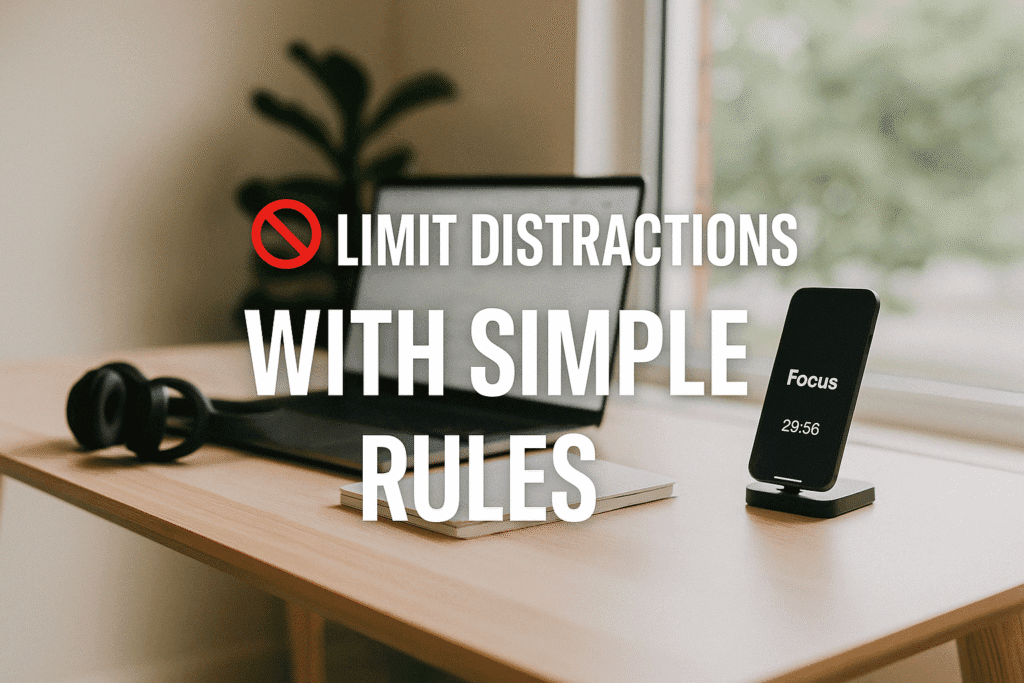
📵 Tip #3: Limit Distractions with Simple Rules
Distractions are everywhere—especially at home. Dishes in the sink, group chats buzzing, and the endless pull of social media. But you don’t need total silence or superhuman discipline to stay focused. Just a few clear, simple rules.
Start with your environment:
- Headphones on = do not disturb 🔇
- Phone on “Do Not Disturb” or in another room during deep work
- Single-task only: keep just one tab or app open at a time
🛑 Set boundaries with those you live with. A simple, respectful cue like “If I have my headphones on, please don’t interrupt unless it’s urgent” can work wonders.
📱 Use focus-friendly tools like:
- Forest 🌲 (grow a tree by staying off your phone)
- Focus To-Do ⏱️ (Pomodoro + task list in um só lugar)
- Cold Turkey / Freedom 🧊 (bloqueiam apps/sites que mais te distraem)
Distractions don’t disappear—but with these rules, você tira o poder delas.
📅 Tip #4: Plan Your Day the Night Before
You don’t need to plan your entire week in detail—but knowing tomorrow’s priorities can make a huge difference. Waking up already knowing what to focus on saves time, reduces stress, and helps you start with clarity.
📝 Before you log off today, take 5 minutes to:
- Write down your top 3 to 5 priorities for tomorrow
- Estimate how long each one should take
- Decide when you’ll do them (use time blocks if you like)
This gives your brain a chance to rest—because it knows what’s coming. No more starting the day checking emails just to figure out what’s urgent.
📌 Bonus tip: Write your plan on paper and leave it visible, or schedule it digitally in your calendar. When the day starts, you’ll already be one step ahead.
🥗 Tip #5: Schedule Real Lunch Breaks (And Take Them!)
Working from home makes it easy to blur mealtime into screentime. One minute you’re replying to an email, and the next thing you know—you’ve “lunched” over your keyboard without tasting a thing.
Taking a true lunch break isn’t just about food—it’s about giving your brain a chance to reset. A proper pause improves focus, lowers stress, and boosts your energy for the second half of the day.
🥪 Here’s how to make your break count:
- Step away from your screen
- Eat mindfully (no Slack, no YouTube)
- Get some movement—stretch, walk, breathe
⏰ Block your lunch on your calendar just like a meeting. Protect that time like your productivity depends on it—because it does.
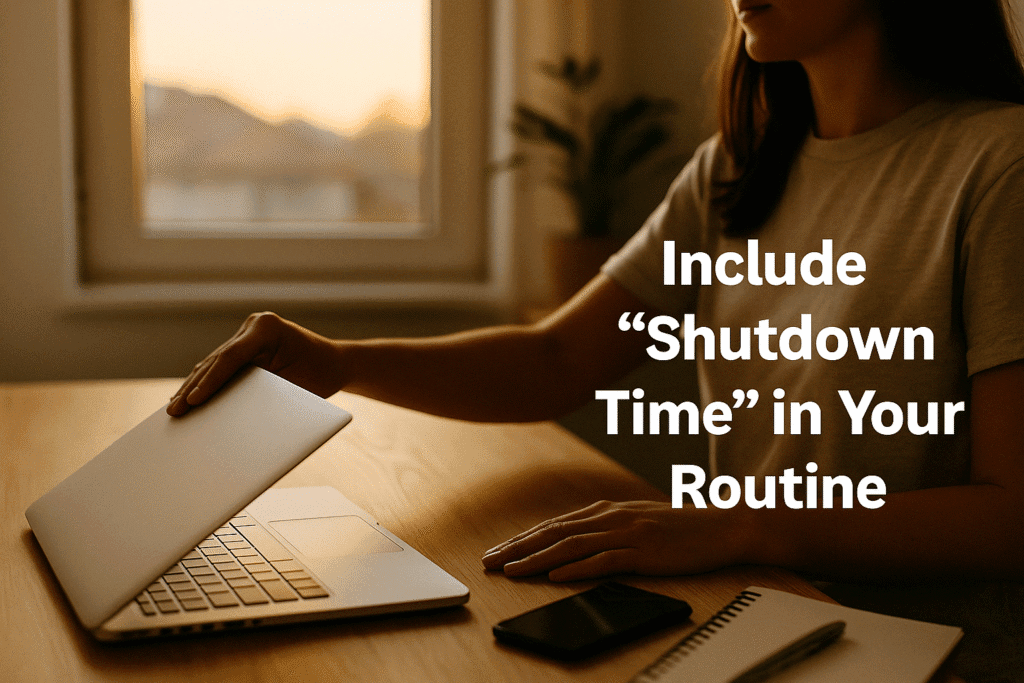
⏳ Tip #6: Include “Shutdown Time” in Your Routine
Just like your computer needs a proper shutdown, so do you. One of the biggest reasons remote workers burn out is because work never really ends—it just… fades into the night.
Adding a short “shutdown routine” at the end of your workday helps your brain switch off and signals: “We’re done for today.”
🧾 Try this simple 3-step routine:
- Review what you accomplished
- Jot down what needs to roll over to tomorrow
- Close tabs, apps, and physically step away from your workspace
🌅 Bonus: Pair this with a “commute replacement” ritual like a short walk, changing clothes, or making tea. It helps shift your mindset from work mode to home mode—even if you never left the house.
It’s a tiny habit that makes a big difference.
🧘 Tip #7: Protect Your Energy, Not Just Your Schedule
Managing your time is important—but managing your energy is essential.
Some tasks drain you, others energize you. Some parts of the day you feel sharp and focused, others you’re running on fumes. When you build your schedule without honoring that, burnout sneaks in.
🧠 Start by noticing your natural rhythms:
- When do you feel most alert?
- When does your focus dip?
- What kinds of tasks feel easy vs. exhausting?
💡 Then adjust your schedule around that:
- Do deep work during high-energy hours
- Save admin or light tasks for lower-energy times
- Include breaks before and after demanding work blocks
Protecting your energy means saying no to things that don’t fit, leaving space to recover, and accepting that you’re human—not a machine.
Working from home can be freeing—but only if you learn how to protect your time, your space, and your energy.
You don’t need to be perfect or hyper-productive. You just need a few intentional habits that give structure to your day without stealing your peace.
Start small. Pick one tip from this list and try it tomorrow. Maybe it’s setting work hours, creating a shutdown routine, or taking a real lunch break. Whatever it is, commit to it—and notice how your day feels different.
Because working from home shouldn’t mean living at work.

Daniel Carter believes that small daily changes lead to extraordinary results. Through simple and effective strategies, he inspires readers to take control of their routines, overcome procrastination, and unlock their full potential.

